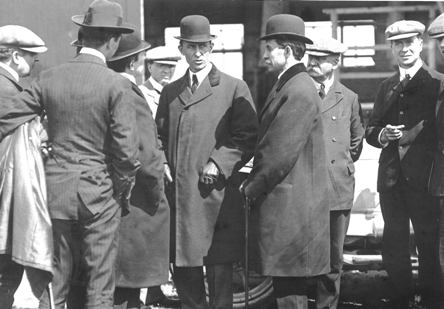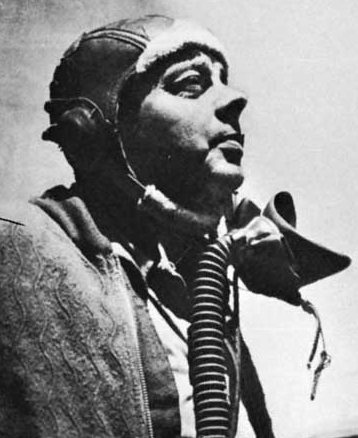
| This category is sponsored by: |  |
|---|
3. The Wright Brothers
Man had been trying to emulate the birds for centuries. Previous attempts had been stymied by several factors, including lack of sufficient propulsive power and directional control. That was until Ohio bicycle manufacturers Orville and Wilbur Wright took their Wright Flyer 1 to Kitty Hawk, North Carolina, in December 1903.

The brothers were notable for their methodical, documented steps in moving towards the first manned, powered and controlled flight. Having studied the way in which birds modified the shape of their wings to manoeuvre, they designed a small biplane glider in 1899. This tested wing warping, or twisting, as a means of turning the machine.
Over the next four years a series of gliders followed, with the 1902 model using the three-axis controls that remain the basis of fixed-wing aircraft control today. These gliders were often flown initially as kites.
The gliders grew steadily larger and increasingly carried a pilot, lying prone on the lower wing.
Results were not as good as expected, however, which led them to a fundamental review of the generally-accepted mathematical calculations for estimating lift for a given size of wing.
The discovery that this theorem seriously over-estimated the amount of lift generated, plus a series of tests on miniature wings in a 2m-long wind tunnel of their own creation, led them to refine their design.
Unable to find an engine with sufficient energy for a powered flight, they devised their own, with their bicycle shop mechanic Charlie Taylor building it in six weeks. They also manufactured two wooden pusher propellers of remarkably efficient form, which were arranged to counter-rotate to eliminate torque.
Kitty Hawk was chosen as their test site partly because of its consistent breezes off the North Atlantic, which would provide a headwind into which the aircraft could be launched and partly because of its remoteness – the brothers were not keen on having the press around after earlier unhappy experiences with journalists.
On 17 December the spruce-framed Flyer, piloted by Orville, finally succeeded in taking to the air for 12 seconds, travelling 36m (120ft). To put this into perspective, this is roughly half the length of a Boeing 747’s fuselage.
Although there are contending claimants for the title of first successful powered flight, it is generally accepted that the Wright Brothers were successful in the first controlled, sustained flight by a heavier-than-air manned, powered aircraft. Everything else follows on from the two brothers from Ohio.
8. Sir Frank Whittle
A classic case of an inventor having to overcome not only technical problems but governmental parsimony, indifference and even outright opposition.
By 1929, Whittle’s thoughts on a new form of motive power had settled on a gas turbine-powered fan enclosed in a fuselage to generate a propulsive jet of air.
With RAF approval, he formed a company, Power Jets Ltd, in 1935 but technical difficulties and lengthy funding negotiations with the UK Air Ministry lingered for years.
Whittle’s determination was vindicated on 15 May 1941 when the Gloster E28/39 took to the air. Some months later the US expressed interest in Whittle’s engine and a copy was given to General Electric.
Typical US vigour resulted in the Bell XP-59A Airacomet flying in October 1942, five months before the Gloster Meteor.
18. Clarence L ‘Kelly’ Johnson
Determined from the age of 12 to create aircraft, Clarence ‘Kelly’ Johnson is acknowledged as one of the 20th century’s greatest names in aviation design and management.
Within five years of joining the young Lockheed company in 1933, he had been appointed chief research engineer. A series of promotions after the Second World War saw him take charge in 1958 of Advanced Development Projects – the company’s famous ‘Skunk Works’.
In his career, Johnson was involved in the design of 40 new types, including the F-104 Starfighter, and the U-2 and SR-71 reconnaissance aircraft. He put his success at maintaining the Skunk Works’ ultra-high levels of security down to minimising the numbers of staff and reports on a project, as well as handing out small sections of the design to his staff, with only he having access to the overall picture.
20. Charles Lindbergh
Charles Augustus Lindbergh became one of the world’s most famous men after he successfully completed the first solo transatlantic flight on 21 May, 1927.
|
|
|---|
©Boeing |
Lindbergh had been consumed by an interest in transport since a child and dropped out of his engineering course at the University of Wisconsin-Madison in 1922 in favour of learning to fly. A period of barnstorming across the country improved his flying skills and he started to look to the Orteig Prize, a $25,000 challenge to the first person who could fly non-stop between New York and Paris.
Lindbergh undertook his transatlantic attempt in a specially-modified Ryan NYP Monoplane, staying awake for 33 hours before bringing the Spirit of St Louis in to a safe landing at Le Bourget, on the outskirts of Paris.
25. Antoine de Saint Exupery
A pioneering aviator with a gift for writing, or one of France’s finest authors who happened to be a pilot? Saint Exupery transcends both categories. A pioneer of early international mail flights in South America and Africa, he saw active service in the Second World War and was posted missing in action while on a reconnaissance flight from Corsica on 31 July 1944.
|
|
|---|
© Brittanica.com |
In 2000, French investigators confirmed that an F-5B reconnaissance variant of the P-38, discovered by divers off Marseilles, was Saint Exupery’s aircraft.
His literary works such as Courier Sud, Vol de Nuit and Pilote de Guerre draw heavily on his aviation experiences. However, his best-known work, Le Petit Prince, is a mystical, philosophical children’s tale in which a pilot stranded in the desert (an experience that had befallen Saint Exupery in real life) meets a child prince from a tiny asteroid. It has become French literature’s most translated work.

100 Greatest
Top 10 | 11-20 | 21-50 | 51-100
Top 5s
Civil Aircraft | Military Aircraft | Person | Moment | Engine
Through the decades
Civil Aircraft | Military Aircraft | Person | Moment | Engine
Source: FlightGlobal.com

























